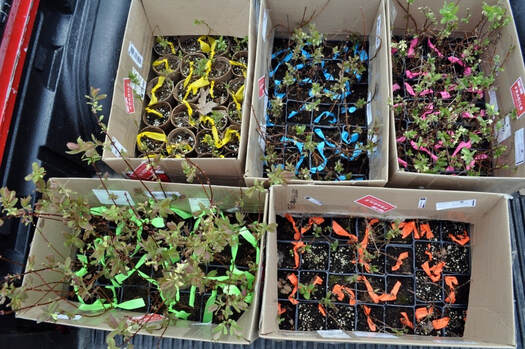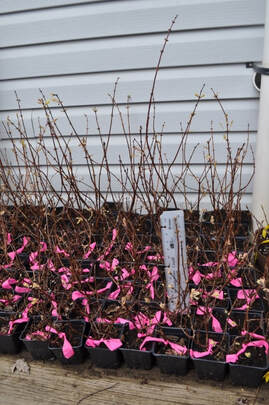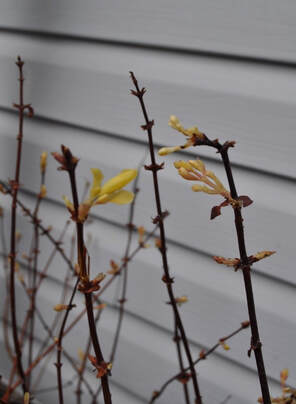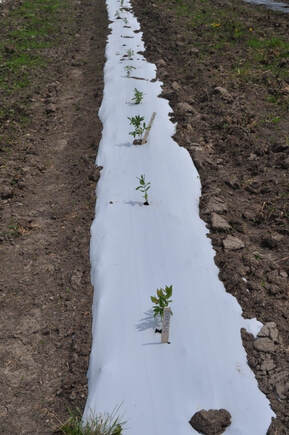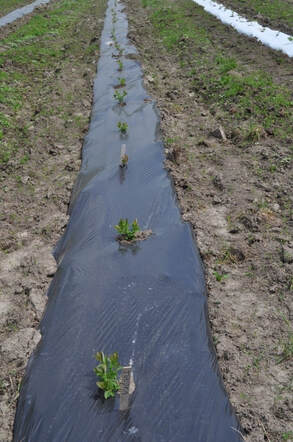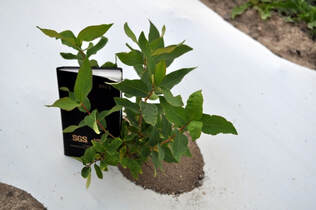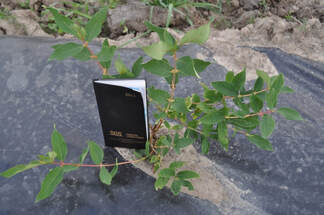Although Ontario farmers did not begin to develop significant Haskap plantations until the 2010 period, the first “regional” evaluation of this new fruiting crop was initiated in 2013. At that time, the North Eastern Soil & Crop Improvement Association began a 2-year field study that saw 16 individual field trials created across the Districts of Northern Ontario, from Bracebridge in the South to Moose Factory in the North, and from the Ontario/Quebec border in the East to Wawa in the West. A final report, focused on growth, soil type, climate, weed management, and “field observations” was formally presented to Ontario SCIA and OMAFRA in the spring of 2015. The final report is available at: Haskap Evalutation and Management Developments Final Report
Haileybury Field Trail, Graham Gambles
Haskap seedlings:
Pictured below are the 4 varieties of Haskap plants; Tundra, Indigo Gem, Indigo Treat and Borealis, ready for planting, with coloured tags to identify the variety in the field. Note that the green leaves have opened before planting as the plants had to be held for a month while the field was prepared:
Haskap seedlings:
Pictured below are the 4 varieties of Haskap plants; Tundra, Indigo Gem, Indigo Treat and Borealis, ready for planting, with coloured tags to identify the variety in the field. Note that the green leaves have opened before planting as the plants had to be held for a month while the field was prepared:
Pollinator Variety:
Haskap variety Czech 17 (Berry Blue) upon arrival from propagator. These plants were more mature than the University of Saskatchewan varieties, note the close up of the dormant buds and emerging flowers (right).
Plastic Mulch Trail:
A field comparison was completed to evaluate difference between white and black coloured plastic mulch. White plastic mulch (left) was used as a means to reduce soil temperature for haskap which are more suited to a boreal climate, versus black plastic mulch (right) which warms soil temperatures earlier in the season.
A field comparison was completed to evaluate difference between white and black coloured plastic mulch. White plastic mulch (left) was used as a means to reduce soil temperature for haskap which are more suited to a boreal climate, versus black plastic mulch (right) which warms soil temperatures earlier in the season.
Mid summer Haskap growth:
Note soil piled around base of haskap to cover the opening in the mulch that was created when the haskap were planted. It was found that strong winds would move the plastic upward, tearing the bottom leaves of the plant. Some growers used soil, others used field stone, wood mulch, or sand, depending on what was available and cheap. All growers who used plastic mulch required weight to hold the plastic down in daily winds.
Results & Conclusions:
- Heavy-duty black plastic, normally used in arboretums, was the ideal choice as a mulch for haskap. This mulch remained intact for over five years.
- White and black plastic mulch, typically used for vegetable farms, would not last longer than two years without tearing, resulting in weed competition after that time. Patching tape was required in the second year, but proved to break off in the winter period.
- Planting direct into soil resulted in loss of the orchard after two years, as hand weeding was essential.
- Mechanical weeding was found to destroy the roots, which grow at shallow depths.
- Chemical weeding destroyed the haskap outright.

